Interesting Stuff
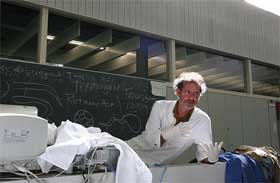 I'm now spending a week in a super boring city. That's the best way i found to catch up with blogging, writing articles for paper mags and working on my own projects.
I'm now spending a week in a super boring city. That's the best way i found to catch up with blogging, writing articles for paper mags and working on my own projects.
First long overdue post is about a fantastic guy whose work i've been admiring for some time. He's called Adam Zaretsky and we met in Edinburgh where New Media Scotland had invited us to discuss the Future Body at the Poker Club.
Zaretsky is a teacher and practitioner of VivoArts, an emerging and politically charged field that brings together art and biology. He has been lecturing and doing research in some of the most prestigious institutes around the world and he is currently teaching at the University of Leiden (NL).
His Vivoarts: Biology and Art Studio course explores five areas where art meets biology (Ecology and EcoArt, Gastronomy and Edible Art, Biology and Bio-Art, Ethology and Art for Non-humans, Physiology and Body Art) and discusses cultural issues such as gene patenting, population diversity (he imagines that we could one day create jellyfish people who'd be floating around the city), new reproductive technologies, nature/culture boundaries, etc. The ethics of living art production are debated and made more tangible and understandable by the use of living material/organisms into the class final projects.
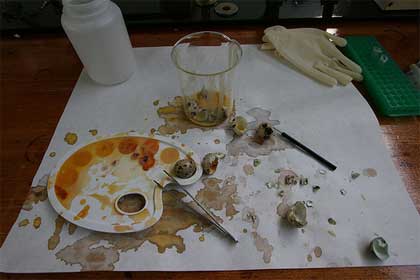
A hands-on approach is crucial to him. Adam believes that without getting your hands "dirty" you can't fully assess the relationship between safety, aesthetics and responsibility implicit in this field. What happens inside a lab is not as squeaky clean as we'd imagine. For example:
 In one of his workshops, Zaretsky has students or participants "paint" with genetically modified bacteria (image on the right); in another, they can incorporate themselves into a work of living art. The idea is to let them see how they can insert their own fantasy and desires right into the genome.
In one of his workshops, Zaretsky has students or participants "paint" with genetically modified bacteria (image on the right); in another, they can incorporate themselves into a work of living art. The idea is to let them see how they can insert their own fantasy and desires right into the genome.
Participants are asked to extract and isolate Hybrid DNA which is found in all living cells. Varieties of samples can be collected from food, pets, pests, human bodies, laboratories and free or not so free living portions of the outdoors. The DNA samples of living, growing, raw or recently alive materials are isolated --using products such as soap, contact lens solution, Woolite-- and put in a blender: vegetable, human, animal, fungus, mold, bacteria, dirty underwear or whatever is alive or uncooked.
In his Leyden class he recently had students create transgenic phaesant and quail embryos. Yes, he's allowed to do that because as he says:
The embryos cannot be allowed to live too long nor can they be inserted into a womb. But still, there's much to learn in the process, like following the development of the embryos and reflecting on the fact that they have no right (Adam even labelled some eggs with names such as "sub-human", "non-being", "loss and lack", etc.) doesn't imply that they are not living and growing beings to which one can give an imprint. At the end of the process he has students choose the way they want their embryo to be killed.
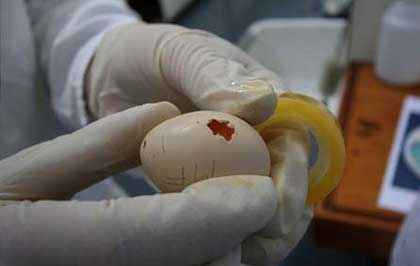
I wish i'd have been fast enough to write down every single witty quote from Adam. Explaining how wild future developments might go he mentioned that
Photos from the Transgenic Pheasant Embryology Lab, credits to Jennifer Willet from Bioteknica.
Last year in early July, i was totally fed up with art, technology, festivals and talks. Only thing i was dreaming about was reading crime stories while eating my own weight in chocolate and figs. Yet, in mid-July i flew to Huddersfield to attend another new media art conference. Its name was We Love Technology and surprise, surprise, i found it nearly as exciting as a novel by Minette Walters combined with a box of Marcolini.
This year Lisa Roberts and her team at BLINK are busy preparing the second edition of We Love Technology. The event will take place on July 12 and people like Andy Gracie, Mirjam Struppek, Mathias Fuchs, Husman Haque, Julius Popp, have been invited to talk about interactive architecture, sound and games. The best thing about WLT is that the gathering is small enough to allow every participant to get to know the others over the picnic, workshops, performances and breaks (i think you can still get some entries.)
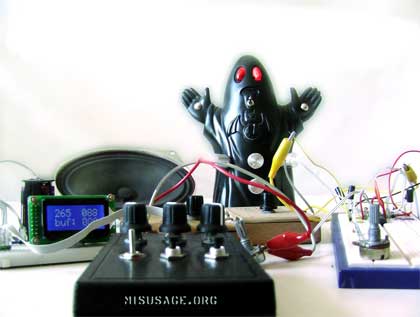
I asked Lisa to tell us more about WLT07:
You're organizing for the second time "We Love Technology" in Huddersfield. Why Huddersfield? Why should people interested in tech-art put the city on their map?
Huddersfield is a big town with equally big ideas and a distinctive and active new media scene. It hosts The Digital Research Unit which is packed with sound artists, games hackers and performers, designers and technologists who generally mistreat and reappropriate technologies.
There is also a 3 month artist-in-residence programme for international artists. They take their experience of Huddersfield with them but often maintain their link through successful partnerships, as in the case of Dan and Tuomo and Tile Toy.
This year WLT will explore interactive architecture, sound and games. What made you choose these particular fields? What do they have in common?
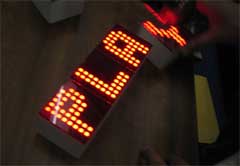 Just to get the ball rolling I chose loose themes from the latest, most interesting and active areas of creative technology, but more than anything I try and bring together a good mix of entertaining speakers who are willing to share their ideas. I have learnt not to over-engineer events as a bit of edginess keeps people from dropping off, especially after lunch. You also have to remember that most of the people who come to WLT will get more ideas from 30 mins of web surfing than 3 days of formulaic conferencing. So it's important to keep it moving along.
Just to get the ball rolling I chose loose themes from the latest, most interesting and active areas of creative technology, but more than anything I try and bring together a good mix of entertaining speakers who are willing to share their ideas. I have learnt not to over-engineer events as a bit of edginess keeps people from dropping off, especially after lunch. You also have to remember that most of the people who come to WLT will get more ideas from 30 mins of web surfing than 3 days of formulaic conferencing. So it's important to keep it moving along.
Last year was the first edition of WLT. What have you learnt from last year that you will definitely repeat this year? And what will you avoid this time?
It can get very warm in July so you need to give everyone plenty of opportunity to break out, breathe and discuss the good stuff in a mix of outdoor spaces. We hope to keep in the picnic element that went down so well last year. I really wanted to showcase some of the great audio performance stuff happening now so the evening session has extended to include some very special drumming from derehctub's Jaxson Payne.
I suppose the main change is that WLT07 is enveloped by a series of three-day hands-on technology DRU workshops where you can learn how to build electronic instruments, take a walk through environmental microbiology networks and modify computer games software.
Join us!
- Liverpool Art and Culture: Turning The Place Over - See the Movie
Turning the Place Over is artist Richard Wilsonâs most radical intervention into architecture to date, turning a building in Liverpoolâs city centre literally inside out. - icLiverpool - City’s new room with a view... but is it art?
Wilson has cut out an egg-shaped section of the derelict buildingâs front and fixed it to a giant pivot. the facade will rotate like a huge opening and closing window, giving passers-by a glimpse of the interior.
- Liverpool Art and Culture: Turning The Place Over - See the Movie
Turning the Place Over is artist Richard Wilsonâs most radical intervention into architecture to date, turning a building in Liverpoolâs city centre literally inside out. - icLiverpool - City’s new room with a view... but is it art?
Wilson has cut out an egg-shaped section of the derelict buildingâs front and fixed it to a giant pivot. the facade will rotate like a huge opening and closing window, giving passers-by a glimpse of the interior.
I couldn't fly to New York to pick up the we-make-money-not-art Webby award. So i asked the cutest guy i could think of to do it for me.
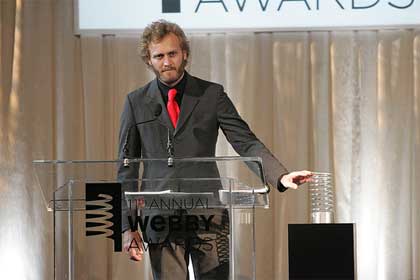
Of course it helped that he had to be there anyway to fetch his company's award. Thanks again Nicolas.
- Sustainable Interaction | Main / HomePage
We encourage submissions exploring the relationship between Ubicomp and environmental sustainability. We ask authors to pick one of the following three options: - Happy Famous Artists : design: lost arcade games of the soviet union
- BBC NEWS | Health | Bear robot rescues wounded troops
The US military is developing a robot with a teddy bear-style head to help carry injured soldiers away from the battlefield. - variable_environment: ESPACE PUR, anti-dust & ionizer "screen"
an air ionizer that uses dust as pixels and that displays patterns thanks to it, in a very slow motion way. It cleans and purifies the air in architectural spaces. It increases the level of oxygenâs negative ions contained in the ambient air. - Rhizome.org: The LightHive: Luminous Architectural Surveillance
Just back from Madrid where the festival PhotoEspaña is on until July 22. Didn't see everything, i just grabbed a programme and went blindly from one gallery to another.
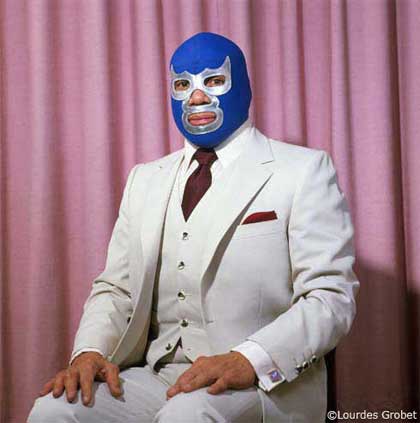
Lourdes Grobet is showing the photos she has been taking for 25 years of Mexican luchadores.
The show is at the Casa America. Mini photo gallery.
If you're in Madrid, my recommendation for the weekend is Medialab Madrid. They've been running a workshop on Magic and Technology and will be showing the results this Saturday, at the Centro Cultural Conde Duque.
Related: Lucha Loco.
Anna Dumitriu is the Director of the Institute of Unnecessary Research and an artist whose work is deeply grounded into scientific research. I met her a few weeks ago at the Mobile Music Workshop in Amsterdam where she was presenting Bio-Tracking, a mobile phone based exhibition using GPS and a software called Socialight which enabled the placement of virtual sticky notes around various locations in Brighton.

Anna sampled various locations in the city for bacteria and moulds, revealing this unseen world to us through digital micrographs. Luciana Haill, Ian Helliwell Ollie Glass and Juliet Kac created a series of sound works to accompany the images. Microbiologist John Paul wrote scientific text descriptions of the microbes.
The use of GPS, to map the locations where the microbiological swabs were taken, brought together the microscopic and the macroscopic, drawing a thread between the satellites orbiting the earth and the bacteria at our feet.
Visitors could download the software and wander around the sites receiving SMS, sound files and images to their phones. Due to the nature of Socialight the exhibition is still live and can be viewed now.
I was so impressed by Anna's enthousiasm and the sense of poetry she brings to an invisible world which i would otherwise find as exciting as a citrus juicer that i asked her to give us more details about her work:
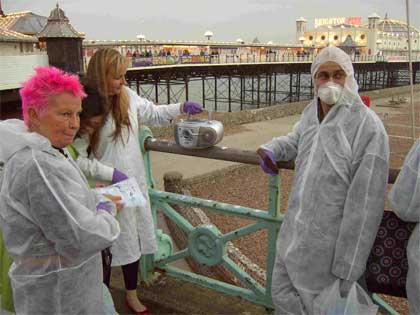
The Bio-tracking Walk Source
How did you get interested in bacteria?
I've always been fascinated with microscopic forms, I think from childhood, but about 12 years ago a key area of research for me was the notion of immortality, that led me to an into an interest in cell biology, looking at immortalised cell lines such as HeLa Cells and I was invited to do a short residency at St Georges Hospital in London in their Clinical Genetics lab, I became increasingly interested in the differences between our media generated notions about science and the deeper story we don't normally get to hear about. The world of normal flora microbiology is really astonishing, to me it's sublime, there are more bacteria on the end of your finger than there are people in the world, I can't really get my head around that.
You told me (if i remember well) that you collaborated with scientists to develop your project. How do you think they perceive your work? Were they interested in your experiments?
Microbiologists seem to love my work because I am studying the things that they don't get to study. You don't become a microbiologist without the same fascination that I have for the microbial world but because of funding and other restrictions they aren't able to study the normal flora. Clinical Microbiology studies that 1% or so of bacteria that can make us ill, the ones I study are considered to be 'of no commercial or medical interest', it's the needle in a haystack thing, there might be something in that haystack worth looking scientifically at but you'd have to go through a huge amount of hay first, it won't produce the quick results or the scientific papers needed to secure funding.
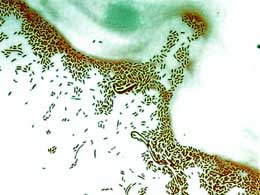 Epistemologically it's an interesting issue, where do we draw the line about what is studied? Money draws that line. But art is judged in other ways by funders, a questioning of our epistemology can be an important issue, the aesthetics of the work, the way the public is engaged is important (in terms of Arts Council England who fund alot of my work), so I can be funded to look at this area as an artist. In terms of scientific support I've been working with Eastbourne District General Hospital (through Arts in Healthcare) and The Royal Sussex County Hospital in Brighton as well as a number of other collaborators and institutions. The use of digital media is also important to me (I'm looking at looking computer modelling of bacteria and artificial life technology) and I am currently Artist in Residence at The Centre for Computational Neuroscience and Robotics at Sussex University, one of the leading Artificial Life research groups in the world, which is an amazing experience.
Epistemologically it's an interesting issue, where do we draw the line about what is studied? Money draws that line. But art is judged in other ways by funders, a questioning of our epistemology can be an important issue, the aesthetics of the work, the way the public is engaged is important (in terms of Arts Council England who fund alot of my work), so I can be funded to look at this area as an artist. In terms of scientific support I've been working with Eastbourne District General Hospital (through Arts in Healthcare) and The Royal Sussex County Hospital in Brighton as well as a number of other collaborators and institutions. The use of digital media is also important to me (I'm looking at looking computer modelling of bacteria and artificial life technology) and I am currently Artist in Residence at The Centre for Computational Neuroscience and Robotics at Sussex University, one of the leading Artificial Life research groups in the world, which is an amazing experience.
I should mention here that I am absolutely an artist, I don't consider myself a scientist, or a hybrid. My relationship to science is that I would rather not collaborate (actually I am not sure if that's entirely true), but what I mean is that I don't feel an artist is fully able to respond to scientific information without a proper knowledge of that subject. I am very hands on, I do all my own lab work (to me it's part of the making) and I am studying clinical microbiology as part of my (Fine Art) PhD, so rather than a superficial engagement with the concepts (a few chats with a scientist where an artist hears about some 'cool' ideas and goes about representing them) I'm basically trying to understand the issues and concepts from the inside and respond to them as an artist in the most informed way. There are equally valid arguements for remaining an outsider, I accept that, and interesting work is being made in that way but it's not how I want to go about it, not something that would achieve the results I am looking for.
I feel very strongly about engaging with the widest possible audience and use my skills to get these issues and concepts out to the public, I don't like the way that scientific language almost seems designed to be incomprehensible (or incommensurable), I believe anyone has the ability to understand anything if it is explained properly. Creating threads and networks of knowldege fascinates me, like bringing crocheters and scientists together to crochet a bed cover based on the light microscopy of the bacteria on my bed. It's a learning curve for everyone but the results, in terms of both the personal exchanges that take place and the resulting art object it's very worthwhile.

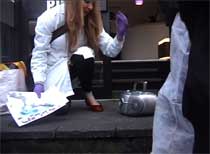
Bio-tracking: Using the GPS and Playing the sound works
How much in general do you think that the science world can learn from the art world and vice-versa?
As far as I'm concerened the "claim to truth" that science has made since the Enlightenment is really now open to question. Notions of rational empiricism seem to be under attack as unachievable. The phenomenological relationship of the experimenter to the experiment is now becoming increasingly key. The ability of art to express multiple layers of meaning, from the analytical and the philosophical to the emotional makes it an ideal method to investigate knowledge within this new paradigm, acting, I believe, as a form of meta-knowledge.
Thanks Anna!
- INDEX:2007 interviews Paola Antonelli
Paola Antonelli's take on design, the importance of beauty - Kultureflash - Architecture week
- Terminal Air - short movie
- Qué es el Pei?: Programa Internacional
- Room Mate Hotels, Madrid
love that one - Architecture Week 2007
- Competition 2007 - Mixed Realities awards
5 networked art works to be exhibited/performed in 2008 at Turbulence.org; Huret & Spector Gallery; and Ars Virtua, a gallery in the online 3D rendered environment, Second Life.
More notes from my conversation with Antonio Cerveira Pinto, the curator of Bios 4. It's probably the first time that so many unstable art works are being shown for several months in a museum (as opposed to a few days in an art gallery during a festival) and, as Antonio notes, the experience has shown that there's a whole new relationship to be built between on the one hand, artists who use technology in their practice and on the other hand, museums which are usually wary of showing works that are not static and "quiet" like paintings are.
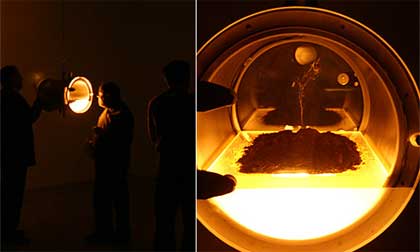
The existence of bio art, environmental art and in general new media art constitutes a challenge for museums. They have to be aware that art is evolving, and open up to new artistic forms. New expertise is needed to deal with machines and living things. Robots need to "rest", for example. Otherwise their electro-circuit dies. Museum curators and directors also have to accept that if you want to hide a computer in a sleek box just because it is "ugly", the container should be big enough to avoid any crash when the machine heats up.
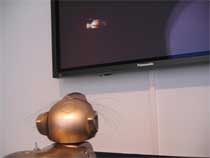
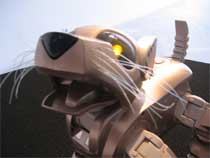
When preparing an exhibition, Antonio Cerveira Pinto likes to set up a small workshop with the museum employees, to explain them what the works are about, how the public should interact with them, what they must be cautious of, etc. I often noticed that exhibition attendants (how do you call them? guards?) seem to be quite happy when they have to keep an eye on interactive pieces. They are proud of showing you how to play with the art work, which buttons should be pushed and how, propose to take a picture of you when you play with a screen-based work, smile when they see how much kids or adults engage with the work, etc. Suddenly they have something to do, they have a knowledge to share.
Artists on the other hand, have to specify clearly how the museum has to manage and take care of the electronic, digital or living bits of their work when they are exhibited over a long period of time (as these pieces are usually shown in the context of a one-week festival). Another challenge for artists is to become experts in usability and design clear interfaces that tell visitors how to interact with their pieces.
The public too has to learn how to engage with these art pieces, adults in particular have spent decades being told "Don't touch!" "Don't go too close!", etc. Both museums and artists will have to take these challenges into account.
First image is from C-Lab's project The Martian Rose. See also their interview and the report they wrote of Bios 4.
Second set of images is from the installation Do robotic cats dream of electric fish? by France Cadet.
Thought that nothing can beat the Hulger? The Strijk-O-Foon (which i'd roughly translate as Iron-O-Phone) works only for Siemens mobile phones though. Plug the iron, wait for a call (or ring a friend) and get the Strijk-O-Foon experience in its full hot glory.
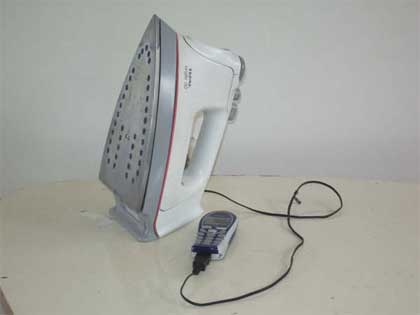
A work by Jelle de Bruijn.
Via Squeaky from.
- Interactive paper sounds exciting
Boring billboards can be turned into interactive displays by using conductive inks to print touch sensors and speakers onto paper. The return of interactive wallpapers!! - Breakthrough brings 'Star Trek' teleport a step closer
A team of physicists has teleported data over a distance of 89 miles from the Canary Island of La Palma to the neighbouring island of Tenerife, which is 10 times further than the previous attempt at teleportation through free space.
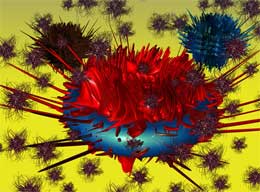 The first Biosphere is Gaia, the planet Earth.
The first Biosphere is Gaia, the planet Earth.
Biosphere 2 was an artificial closed ecological system constructed in 1987/89 in Arizona. It was used to test how people could live and work in a closed biosphere, while carrying out scientific experiments. It explored the possible use of closed biospheres in space colonization, and also allowed the study and manipulation of a biosphere without harming Earth's.
BIOS-3 was a closed ecosystem at the Institute of Biophysics built between 1965 and 1972 in Siberia. It consisted of a 315-cubic-metre habitat suitable for up to three persons.
BIOS is also a computer term that stands for Basic Input/Output System.
Bios 4 is the exhibition on bio and environmental art currently running in Sevilla and if you trust dear old aunt Régine, you should book a flight to Sevilla and visit the show because you're not going to see anything like that anytime soon.
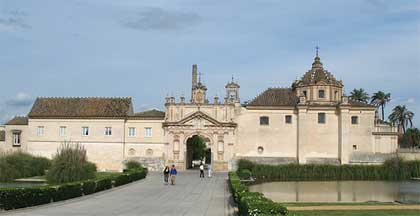
The Centro Andaluz de Arte Contemporáneo (image by Amy Youngs)
Here's the blurb about the exhibition:
The launch of the Human Genome Project in 1990 -the identification of the 20.000-25.000 genes of human ADN- would have been difficult to realize in only 13 years without the power and speed of digital computers. That's also the moment when environmental and biological art started to emerge. Bios 4 is an exhibition and an information platform that showcases a selection of examples of these two important categories of art on the 21st century.
The close collaboration between artists, scientists and technology experts to develop new creative projects characterizes this recent area of investigation that brings the art closer to knowledge. That's what the curator of the exhibition, Antonio Cerveira Pinto, calls "cognitive art." Cognitive Art emerges when artists have to build up specific scientific or technological set of skills and knowledge in order to use them in their own artistic process. The use of this new knowledge and cognition symbolises a "post-contemporary" culture. The artists' work is not always perfect in terms of form, what matters is the questions that arise from it.
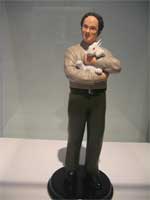
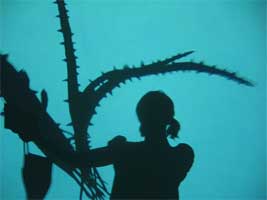
A statuette of Eduardo Kac with Alba (!!) and Mark Ct;Mark Cypher's spectacular Biophilia
The raw material of artistic expression of biotechnological art or bioart, which has some roots in the Body Art of the 1960-70, is life itself or its components (genes, organs, organisms, tissues), or the virtual living matter, digital stimulation of ADN, of proteins, and of course it can also be the result of the intersection of those two realities. A philosophical and ethical debate has recently sparkled from the interest for the new potential for manipulating the living. Bioart takes part into the discussion with works that often reflect an ironic metaphorical exercise or a clearly critical one.
For the art of nature/ecologiy/environment or of sustainability, which antecedents can be traced to the Land Art of the '70s, the medium of artistic creation is the natural sphere in all its extensions and complexities. The idea of the close connectivity between all the organisms that represent terrestrial life for billions of years inspire the dynamic definition of this new artistic field. Issues of pollution, the exhaustion of fossil fuels of energy sources and global warming are turning into the main areas of concern of the environmental artists of this new century.
Antonio Cerveira Pinto points out that the art arising from post-contemporary complexity does not focus on the forms spawned by technology but focuses on the worlds that are possible for a humanity surrounded by technology while threatened by energy exhaustion and ecological imbalances. The works selected in Bios 4 bear witness to a way of making art that embodies both scientific curiosity and the poetical formulation of a new type of knowledge.
Image on top left corner is Machinic Diatoms by Ken Rinaldo. The 3D irrealities envision the day when designer molecular constructors will permit unicellular machines, nano machines to co-inhabit (invited or not) and maintain the body.
Bios 4 - Technological and Environmental Art runs until September 2 at the Centro Andaluz de Arte Contemporaneo, Sevilla.
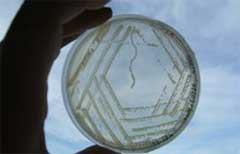 Another work seen at the Bios 4 exhibition:
Another work seen at the Bios 4 exhibition:
Decon, Marta de Menezes's latest project is a series of "living" artworks inspired by Piet Mondrianâs geometric paintings.
The colors from those paintings are progressively degraded by the bacteria Pseudomonas putida MET94, a "microorganism of putrefaction." With an appetite for organic pollutants, this soil microbe has the potential to be used for bioremediation, a process that uses microorganisms, fungi, green plants or their enzymes to return the environment altered by contaminants to its original condition. The artist collaborated with LÃgia Martins whose research lab investigates the use of inoffensive bacterias to "clean" up textiles which are coloured with nocive chemicals. Cleaning and de-toxing them means that the textiles can then be recycled.
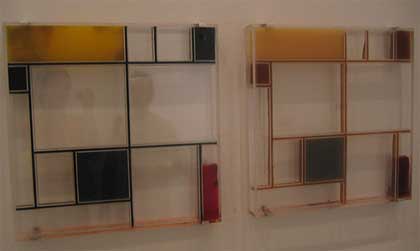
The "paintings" only exist while they are being degraded by the bacterias which are living, and dying in the gallery space. Thus, one can interpret those paintings as a process of death and decomposition of the artwork. The strange thing was to see how some colours were fading faster than other. While the blue, for example seems to be literally eaten up, the yellow was covered with dark stains.
- CB2 baby humanoid robot ::: Pink Tentacle
Osaka Universityâs Graduate School of Engineering unveiled a robot that acts like a human infant, which they hope may one day help scientists better understand the child development process. - Putting people first » Bruce Sterling moving to Torino, Italy
OMG! Turin does not deserve you Bruce. - Dave and Esty » Grill-on-the-run
A fully portable hand held grill requiring nothing more than a flame and your favourite cut of meat. - NewGenics: If You Build It (out of DNA), They Will Come (with money)
What is constructive biology? it's a trademarked neologism that a start up named Codon Devices is using to position themselves as the avant garde in biotech.
Yesterday i spent a few fantastic hours with Antonio Cerveira Pinto in Sevilla. He showed me around Bios4, the exhibition about bio and environmental art he curated at the Centro Andaluz de Arte Contemporaneo. I am going to write about it from A to Z, focussing on some of my favourite pieces and bits of my conversation with Antonio. But let's start the lazy way with just an appetizer of what i've discovered there.
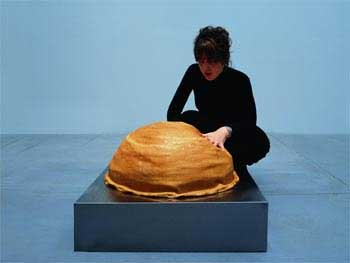
Alexithymia is a term that means the incapacity to verbalize emotions. When some sufferers want to talk but are unable to utter the words, they start sweating to manifest the desire to communicate.
Alexitimia is also the name that Paula Gaetano, an artist from Buenos Aires, gave to her robot. It's a big blob that feels like rubber when you touch it. But it also sweats when you caress its surface. Paula Gaetano has a background in fine art but collaborated with scientists and techno experts to develop the robot. The only sensors are for touch and the only output is water that runs from a tank hidden in the base of the work.
It is creative intuition that permits both the artist and the viewer to leap over logic, whether scientific or artistic, and emotionally experience the problem laid out here of reconciling the "wet" domain of nature with the "dry" domain of electronics.
Winner of Vida 9.0.
Image mas de arte. The robot is not physically in the exhibition but only documented. Flickr set from the exhibition.
A documentary that Shawn Bailey and Jennifer Willet from Bioteknica did a couple of months ago with Vision 360 has popped up on YouTube.
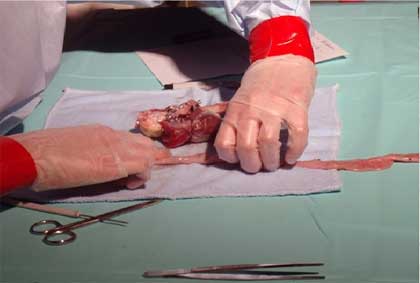
They talk about "live" tissue engineering, meat sculpture, bioart, and the need to raise public awareness on biotechnology and its impact on society.
Check also these Bio-Blurb radio interviews of people whose work intersects art and science, and particularly biological and genetic sciences.
Thanks Jennifer!
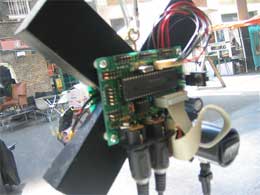 Yesterday afternoon i went to the Kinetica museum in London. It's a big glass box space located right in the middle of the Old Spitalfields Market, a place where people buy fake vintage t-shirts while munching on their organic sandwiches.
Yesterday afternoon i went to the Kinetica museum in London. It's a big glass box space located right in the middle of the Old Spitalfields Market, a place where people buy fake vintage t-shirts while munching on their organic sandwiches.
Soundwaves, the museum's current exhibition focuses on artworks that explore, warp, collect and manipulate sound and it is really good.
Favourite piece is Julie Freeman's Specious Dialogue. It took me a while to notice the existence of these unassuming cubes on wheels. They are made in concrete and can be pushed, rolled, kicked (didn't try) and shoved around the gallery.
The white cube is the "listener". If the sound around it suddenly gets louder â" if someone knocks it, whistles, speaks, or shouts at it â" it will start recording and store the sound (active mode). Sometimes the recorded sound will be passed to the black form for playback after a few seconds, sometimes it will be stored for future use, inserting it into someone elseâs dialogue.
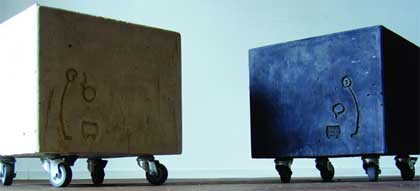
The grey form is the "speaker". It constantly outputs its chatter. Which sounds is it speaking is determined by two factors â" the distance between it and its white friend and whether or not the system is in active mode.
In active mode, the microphone in the listener allows contributions to be fed into the work, and the pre-recorded dialogue changes from personal to public. Pre-recorded sound clip harvested from all over the world are interwoven with recordings from the gallery and played back. Volume, distortion and tempo is altered capriciously, often changing the live and existing recordings into mumbles.
When the work it is the distance between the cubes that dictates which conversational fragments are played. Up close, they laugh, but also voice their contempt. When far apart they miss each other, but also they are angry and need their space.
Other works i liked:
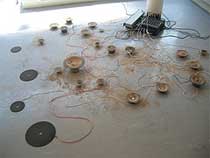
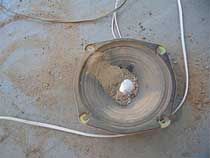
Lu Clarke & Jaye Ho have scattered 22 speakers near one of the entrances of the museum. The speaker diaphragms contain dust and dirt. When you enter the space, the sound of your footsteps captured by the contact microphones hidden under the floor and processed by a reverb effect-unit to repeat and echo. The sound is made visible throught the diaphragm that vibrates and agitates the dirt.
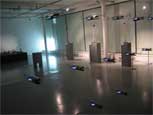
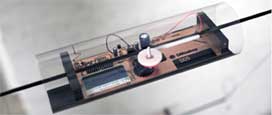
Martin Hesselmeier and Karin Lingnau's SARoskop is made of 25 objects hanging from wires from the ceiling and reacting to their electromagnetic environment, transforming the data into movement and oscillations.
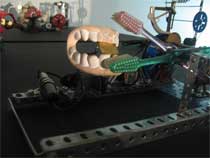
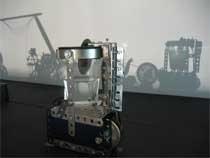
Upstairs a lovely orchestra of teapots, toothbrushes and other household objects by Pierre Bastien is playing with its shadow.
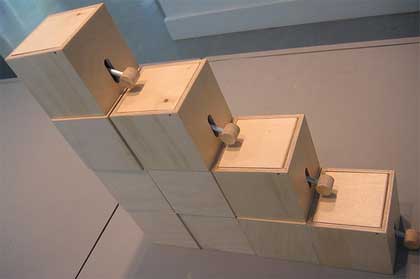
Andy Huntington's marvellously simple tapTap wooden boxes. Each box has its own memory and is self-contained. Tap on a box and a few seconds after the box taps back your knock. Tap on several boxes and they will all repeat your composition. The more boxes you use, the more complex the rhythm lines. By tapping for longer than the delay period, you play a duet with tapTap as it repeats your earlier rhythm.
Image on the top left corner is from Michael Markert's installation kill 2.1.
My images.
Soundwaves, a collaboration with Cybersonica, runs until 29 June, at the Kinetica Museum in London.
"The virtual communities created by online games have provided us with a new medium for social interaction and communication. Avatar Machine is a system which replicates the aesthetics and visuals of third person gaming, allowing the user to view themselves as a virtual character in real space via a head mounted interface. The system potentially allows for a diminished sense of social responsibility, and could lead the user to demonstrate behaviours normally reserved for the gaming environment."
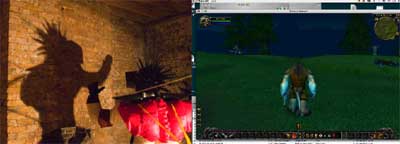
That was the blurb i read on the website of Charming Disaster , an exhibition featuring several works created by students of the Royal College of Artâs Design Products department (thanks Noam for telling me about it!) What i like about Avatar Machine is that, like the One Eye Ball but unlike several similar projects i've blogged in the past, it's not just about coming up with a nice, funky, geeky project before everybody else, it is also a very eye-pleasing work. I love the way that the designer pushed the concept further by making the user wear the costume of an avatar, i imagine that it allows observers to participate (albeit in a much more discreet way) to the experience. So i asked design student Marc Owens to tell me more about the work.
How does it work technically?
The system works in a very simple way. The user wears a body harness, which has three 2m long aluminium rods protruding from it, to form a type of tripod. A wide angle pinhole camera exists at the point where all three rods meet. The camera is pointing directly back at the user. The video footage being recorded by the camera is transmited to the monitor inside the headset so it can be viewed by the user. Therefore the user can see themselves in the third person, from head to toe on the monitor interface.
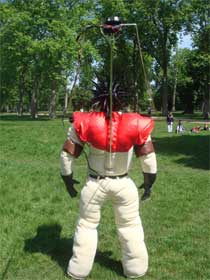
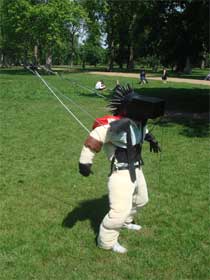
It is WoW that inspired the kind of costume that the player has to wear in your installation, did i get that right? Any reason why you chose to refer to WoW?
Thirdly, i am ashamed to admit, quite a fan of World of Warcraft!
Which kind of behaviour did you observe when visitors of the Charming Disaster were playing with your work?
At the Charming Disaster show a few weeks ago, the screen within the headset burned out after an hour into the performance. So only one or two people had the opportunity to experience the system. However since then, i have carried out some avatar sessions in Hyde Park, allowing ample room for the user to do as they wish, and behave as they like.
The types of behaviour i observed were all quite similar. That being, everyone was quite cautious with their movements to begin with, moving around with baby steps as they slowly got used to controling their movement from the third person perspective. After a few minutes, users began to gain confidence not only with faster and more fluid movement, but also began to mimic the types on movement that they imagined the avatar would demonstrate, ie: stoping around and swinging of arms. Another element to the type of behaviour i observed was that after getting used to using the system, users felt comfortable enough to approach passing 'humans' and observed their reaction through the interface.
All images courtesy of Marc Owens.
Andrew Doro and Pravin Sathe are working on a series of everyday items that deal with the life embedded within the objects, we buy, use and ultimately discard.
In the second series, Detritus (III - XIV), the artists focused on travel anxiety and created airline sickness bags that breathe when closed but start hyperventilating as soon as they are opened.

How does Detritus work? "There is a photocell that measures light, it just acts like a switch," explains Pravin Sathe. "When the bag is closed the photocell gets no light. We have it programmed so when there is no light it breathes slowly. When the bag is opened and the photocell receives light, the program tells it to breathe fast. The "breathing" is caused by a servo motor with two strings on either end attached to the side of the bags."
The objects comment on "ubiquitous computing", which promises to animate household items. In this case, items which do not appear to be computerized, particularly not for any practical purpose.
There's also the fear that ubiquitous computing can be harnessed to develop Improvised Explosive Devices and lead to technological paranoia. The artists hope to append their own ideas to ubiquitous computing reaching outside its helpful or nefarious aims into something more amorphous and ask the question: "Do inanimate objects have a life?" (more)
The next series the duo is working on are umbrellas that "breathe" as more carbon dixodie is added to the room (ie, more people in the room, the more an umbrella opens, the less people the less it opens).
Blogged by Hack41
. . . . . . . . . . . . . . . . . . . . . . . . . . . . . . . .
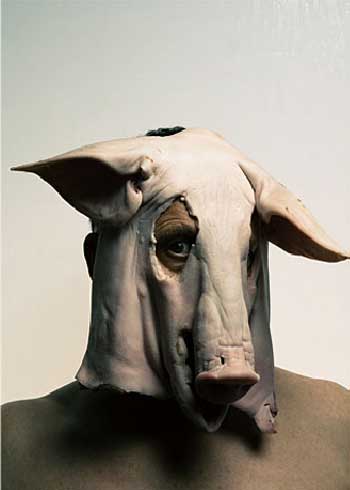

0 Comments:
Post a Comment
<< Home